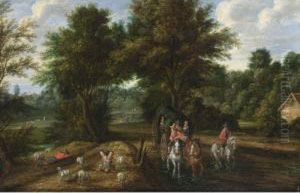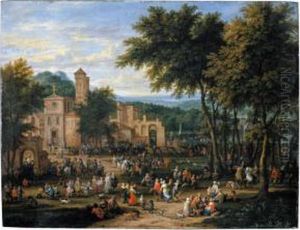Boudewyns Adriaen & Bout Peeter Paintings
Adriaen Frans Boudewyns and Peeter Bout were two Flemish painters who often collaborated on paintings, particularly landscapes and cityscapes. Boudewyns was born around 1624 in Brussels, where he would spend the majority of his life and career. He specialized in painting landscapes, often embellished with architectural elements, and was influenced by the works of other Flemish artists such as Jan Brueghel the Elder.
Peeter Bout was born in Brussels around 1658, and his primary focus was on painting staffage, the human and animal figures that populate a scene. These figures were often integrated into the landscapes painted by Boudewyns, creating a collaborative synergy between the two artists. Bout's figures were dynamic and brought life to the scenes, which was a perfect complement to Boudewyns' detailed and structured environments.
Both artists were members of the Guild of Saint Luke in Brussels, which was the city's painters' guild. Their collaboration is a fine example of the co-operative practices among artists during the 17th century in the Low Countries. Boudewyns' landscapes with Bout's figures were popular among their contemporaries and are considered to be some of the finest examples of Flemish landscape painting from that period.
Adriaen Frans Boudewyns is believed to have died around 1680 in Brussels. His works can be characterized by their sophisticated treatment of light and atmosphere, which he used to create depth and realism in his scenes. Peeter Bout lived longer, continuing to paint and contribute figures to the works of other artists until his death, which is estimated to have been around 1719. The partnership of Boudewyns and Bout remains a significant footnote in the history of Flemish art, showcasing the successful and harmonious collaboration between two specialized artists.

